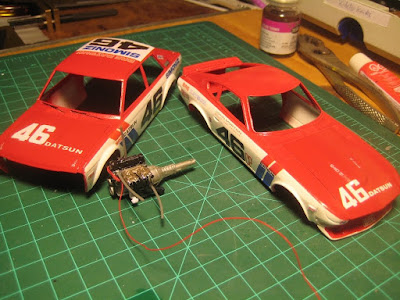
The various bits include a catch tank for the crankcase breathing system (silver box, right side firewall, which I earlier mistook for an oil reservoir); a remote oil filter (not yet installed in the pictures; it will go on the right side suspension tower) with an oil temperature thermostat (inner fender ahead of the right side suspension tower) leading to the oil cooler (not yet installed, it will go on the right side of the bulkhead next to the coolant radiator). There is also coolant piping to a remote ethylene glycol reservoir (left side inner fender). All very neat, with the only comment being that the tubing supplied is the wrong colour (grey rather than black) and is also fairly inflexible, so that bending it to get it to hook up to the second connector tends to pull it off the first. I found some black tubing in the spare parts bin that is more flexible, somewhat like the heat shrink stuff used for electrical connectors. I've been using CA glue here.
The upper picture also shows the steering box, probably a worm-and-sector unit, partly hidden under the carbs.

There is also a pair of brake master cylinders (partly obscured by some tubing) and a brake fluid reservoir (white box, left side firewall); I didn't bother to make tubing to connect the masters to the reservoir, although I suppose you could get carried away. The kit also includes a wiper motor (dark gray, left of centre on the firewall). The long red wire is meant to go to the coil, but the kit doesn't seem to have one; I'll rummage around in the spare parts bin to see what I can find. Brownie points if you can spot the error in the spark plug wiring. Hint: it has nothing to do with firing order.
Glancing at the instruction sheet for the BRE 240 Z, it would appear to be equally well detailed. So these are two very nice kits that will reward an experienced modeler, but the plumbing is probably a bit much for a beginner.
Note when I say left or right, I am referring to vehicle left or right, which is the reverse of left and right in the photos. This habit of reversing left and right to conform to conventional left and right in a vehicle when looking at it from under the hood, along with my mild level of dyslexia, is a major source of confusion on a regular basis, as many of my friends will attest. That's my story, anyway, and I'm sticking to it; it has absolutely nothing to do with my advancing age or any alleged loss of mental faculties that might be related to same, or, like, to prolonged exposure to model airplane glue, man.








